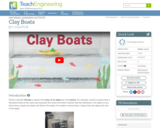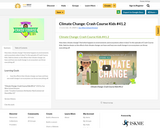
Students design, build and test model clay boats that can hold weight.
- Subject:
- Science
- Material Type:
- Lesson
- Provider:
- TeachEngineering
- Provider Set:
- TeachEngineering
- Date Added:
- 10/14/2015

Students design, build and test model clay boats that can hold weight.

Hydropower generation is introduced to students as a common purpose and benefit of constructing dams. Through an introduction to kinetic and potential energy, students come to understand how a dam creates electricity. They also learn the difference between renewable and non-renewable energy.

Students are challenged to design a method for separating steel from aluminum based on magnetic properties as is frequently done in recycling operations. To complicate the challenge, the magnet used to separate the steel must be able to be switched off to allow for the recollection of the steel. Students must ultimately design, test, and present an effective electromagnet.

Students observe and discuss a simple balloon model of an electrostatic precipitator to better understand how this pollutant recovery method functions in cleaning industrial air pollution.

Students investigate decomposers and the role of decomposers in maintaining the flow of nutrients in an environment. Students also learn how engineers use decomposers to help clean up wastes in a process known as bioremediation. This lesson concludes a series of six lessons in which students use their growing understanding of various environments and the engineering design process, to design and create their own model biodome ecosystems.

Engineers design methods of removing particulate matter from industrial sources to minimize negative effects of air pollution. In this activity, students will undertake a similar engineering challenge as they design and build a filter to remove pepper from an air stream without blocking more than 50% of the air.

Posed with a paradigmatic engineering problem, students consider and explore mathematical algorithms and/or geometric concepts to devise possible solutions. The problem: How should a robotic vacuum move in order to best clean a floor of unknown shape and dimensions? They grapple with what could be a complex problem by brainstorming ideas, presenting the best idea for a solution and analyzing all presented solutions, and then are introduced to an elegant solution. Rather than elaborately calculating the most efficient route and keeping track of which tiles the robot has visited, a random number generator determines which direction the robot will take when it hits a barrier. Students are able to visually confirm how an unfamiliar programming concept (a random number generator) can make for a simple and efficient program that causes an NXT robot (that is suitably equipped) to clean a bare floor. Then students think of other uses for random numbers.

Students learn about a special branch of engineering called bioremediation, which is the use of living organisms to aid in the clean-up of pollutant spills. Students learn all about bioremediation and see examples of its importance. In the associated activity, students conduct an experiment and see bioremediation in action!

The Clearer Thinking website helps people and organizations make better decisions and think more clearly, just like its name says. It uses fun, interactive games and quizzes based on evidence to help us think more logically.
*Comprehensive personality test for learner profiles
*Tools
*Courses
Understand yourself, improve your mood, accomplish your goals, make better decisions, recognize faulty logic, understand the world!

Following the steps of the engineering design process and acting as biomedical engineers, student teams use everyday materials to design and develop devices and approaches to unclog blood vessels. Through this open-ended design project, they learn about the circulatory system, biomedical engineering, and conditions that lead to heart attacks and strokes.

Study Guides - for almost anything you can study at school!
Literature Notes - for over 300 novels / books including Shakespeare, Catching Fire and many more! Includes summaries, character info, symbols, questions, quizzes (some), and analysis.
Test Prep - from high school to grad school (USA-based)

Climate Challenge is a single-player game about climate change, playable for free on the BBC website. It is a sandbox-style strategy game based on real climate change data, where the player can try out different approaches, learn about the issues and have fun at the same time.

In this video, Bill Nye, the Science Guy, explains what causes climate change, how it affects our planet, why we need to act promptly to mitigate its effects, and how each of us can contribute to a solution.

How does climate change? And what happens to environments and ecosystems when it does? In this episode of Crash Course Kids, Sabrina shows us the effects that climate change can have and how one small change in an ecosystem can throw everything off.

In this self-paced tutorial, educators learn about the kinds of educational experiences that prove effective in exciting students about STEM careers and identify resources that can be used to introduce students to STEM careers, especially those related to climate change science. Profiles of scientists and engineers representing diverse populations are included for use in the classroom. Multimedia educational resources including video clips and vocabulary words linked to a glossary are included. This is the eighth of ten self-paced professional development modules providing opportunities for teachers to learn about climate change through first-hand data exploration.

Suney Park wants her students to know that what they learn in class is relevant to their lives and the world. In this introduction, she shows us how her students come up with a plan to recreate the Earth and its atmosphere and test their own hypotheses about rising CO2 levels.

Suney Park's hands-on activity has her students making the greenhouse effect happen in a model. Using a light bulb for the sun, they create different control groups that imitate Earth's atmosphere with the help of a soda bottle. This adds up to a meaningful experience that connects what students learn in class to real-world events.

After a month studying climate change, students create models of the earth and its atmosphere, and design experiments to test the variables involved in climate change. Students write their own driving questions, develop hypotheses, and build the models to use in their experiments.

Suney Park has her class of scientists set up their experiments step-by-step. Even though it can be chaotic and mistakes can be made, there is purpose and meaning to having the kids be responsible for all aspects of the experiment and the learning that goes on in that process.

After a butterfly species disappeared from a location where it had been found for many years, conservation professionals accessed climate projections to identify potential habitat for its recovery.